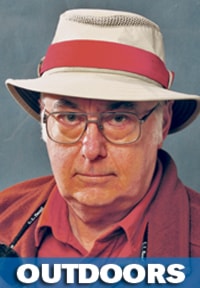Perhaps because of the floods last year, Alberta anglers are expressing curiosity and concern for the state of Alberta’s stonefly populations, particularly the species that most interest the trout and those who fish for them.
Going back over fishing diaries documenting my more than 45 years of chasing these hatches — trying to be on the right river or stream where and when they occur to enjoy the fast fishing they produce — I’d have to judge that most of them are going to be late this year.
Late is also what my wild flower indicators for when anglers’ hatches will appear are also saying.
Three- to four-year-old nymphs of the salmon fly, Alberta’s largest stonefly, emerge from our waters when the dogwood flower buds are just about to burst into white bloom, then “hatch” or transform into the winged adults. My most recent check of a dogwood bush showed miniscule flower buds just getting started.
The earliest I have ever fished a good salmon fly hatch in Alberta was on May 16, after a soft winter and a warm, dry spring, conditions very different from what we have been experiencing around here since Nov. 1 last year.
But I expect the coal-black mature salmon fly nymphs are starting to move to the shallows, ready to crawl out of the water en masse when its temperature reaches 17C (63F) for at least three days.
My late fishing buddy, Lloyd Graff, loved to fish big, black salmon fly nymph imitations near shore during the underwater migration of the three- to four-year-old naturals, an easier event to predict than the legendary egg-laying flight of the mature, winged adults.
The late Charlie Brooks, guru of the Madison River, which has the world’s most famous Salmon fly hatch, maintained fishing salmon fly nymphs was always a good bet any time because the various age classes were always in the river.
When I fished the Madison’s Barn Holes with Charlie, he was slinging serious lead, two huge, heavy salmon fly nymphs, one black, and one white, on the same leader.
He wasn’t sure why the white one, except that it often worked. I was curious because my all-time favourite and most successful “black” salmon fly nymph imitation was the reddish-brown Bird’s Stonefly Nymphs I ordered from Dan Bailey’s in Bozeman, Montana.
Eventually I found the answer to my colour conundrum in my collecting net.
Among the hard shell, coal black salmon fly nymphs there would often be one or two soft, brown ones. Two stonefly experts explained to me that these were specimens that had just molted their hard, black shells and before the soft chitin hardened and blackened again.
At this stage, the red-brown nymph is soft, succulent, and the trout love them, much as many humans, myself included, dote on soft-shell crabs that have just molted their hard shells.
Thus is revealed the secret of the brown salmon fly nymph.
Once ashore, the nymphs grip onto a rock, reed or limb, heave until their shell splits and the winged adult eventually pulls itself through the crack.
From then, the totally unpredictable anglers’ watch and wait takes place for the adult flies to mate and the huge females to fly onto the water to lay their eggs, causing an orgy of gluttony for trout and dry fly fishermen alike.
Anglers come from all over to catch this event on the Crowsnest River, site of Alberta’s most famous salmon fly hatch.
In many years, anglers who miss the salmon fly totally can solace themselves by catching the hatch of the skwala, a much smaller stonefly, on the Red Deer River tail water, right down and through the city, generally around the May long weekend, or when the chokecherries are in full bloom on the banks.
That, I fear, is also going to be late this year, judging by what peering at nearby chokecherry bushes is telling me.
Alberta’s longest and most well-known stonefly hatch is the golden stonefly, the adults of which are almost as large as the salmon fly.
This hatch takes place seemingly at all altitudes and in all parts of Alberta when our floral emblem, the wild rose, is in bloom.
Alberta’s winter-spring syndrome may have moderated enough by then that roses and golden stones may arrive together and right on time this year.
Anglers constantly fret that the heavy floods we have been suffering too many of in recent years harm the aquatic insects upon which their fish and fishing depend.
That is the case with many caddis and mayflies, but stoneflies are robust creatures, strong grippers, that shelter among rock and boulders, and generally survive even the worst floods.
In fact it has been my observation that recent heavy floods on certain Alberta rivers and streams have actually rehabilitated formerly good stonefly habitats by flushing out the accumulated silt that had been covering the bare boulders, rocks and stones, the absolute essential building blocks of stonefly heaven.
Bob Scammell is an award-winning columnist who lives in Red Deer. He can be reached at bscam@telusplanet.net.
